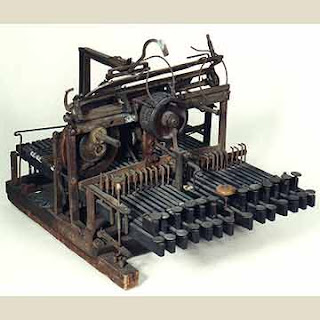
a man called Johann Gutenberg invented the printing press with loose type in the 15th century. he cleared the way for the gradual proliferation of the printed word.
the obvious progression from this stage would be to use this wonderful printing technology to design a machine that could take over the cumbersome task of handwriting. the mechniasm in a clock is far more advanced than in a typewriter so why did it take the inventors over 400 years to create a typewriter.
well it seems there was no need for typewriters in a world were cheap labour was dominant and machines were expensive. it was not until later. till the 19th century. that there was indeed a need for the typewriter.
mass production of this typewriter : the sholes and glidden began in 1873.

this was a big evetn and was featured on the front page of scientific american.

so the typewriter then became one of the great inventions of the 19th century comunications technology, alongside the telegraph. telephone. photography and gramophone. it gainwd a respected place in wealthy homes. this is a family portrait from around 1890 where the three men play violin (left), read a book (right) and write on a typewriter(center).

some of the typewriter we we say today still have things in common with these designs: the qwerty keyboard. some inventors did come up with some crazy designs for what the typewriter could possibly become.

the object played a role in socia history, it forced the way for women in the office.

the typewriter gave women jobs in the office and an opportunity to work as freelance 'typewriters' in offices where a fulltime use of a machine was not feasible yet.
i suppose in a sense, this object contributed towards giving women social economic power, an equal position in the labor force and a voice in business.
althought i think this led to affairs between men and their typewriting secetaries....



this is an example of the earliest know of a typewritten letter. it was typed in 1869 by sholes talking about several aspects of the work he was working and writing on.

early early models.




this 'pocket typewriter' hit the market fro modern gadgets in 1887 and is one of the smallest index typewriters ever produced. being less than ten cms long it much have been a great conversation point.

the primitive machine was operated by placing it on a piece of paper with the enamled idex to the right. the index was rotated until the desired character stood on the left. the letter was rpinted by pushing the index down onto the paper. the machine would then be pulled one space forward. friction was caused by two rubber bands around the wooden roll.

the quality of the writing produced depended completely on the even handedness of the operator. the slightest move would cause a mistake.

i want one.

No comments:
Post a Comment